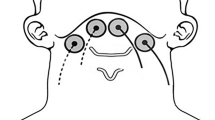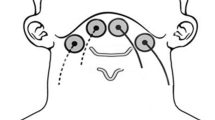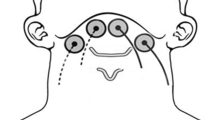Abstract
This study sought to determine whether air-pulse trains delivered to the peritonsillar area would facilitate swallowing in healthy subjects. Trains of unilateral or bilateral air pulses were delivered to the peritonsillar area via tubing embedded in a dental splint, while swallows were simultaneously identified from their associated laryngeal and respiratory movements. Results from four subjects indicated that oropharyngeal air-pulse stimulation evoked an irrepressible urge to swallow, followed by an overt swallow as verified by laryngeal and respiratory movements. Moreover, air-pulse stimulation was associated with a significant increase in swallowing frequency. Mean latency of swallowing following bilateral stimulation tended to be less than the latency of swallowing following unilateral stimulation. These findings in healthy adults suggest the possibility that oropharyngeal air-pulse stimulation may have clinical utility in dysphagic individuals.





Similar content being viewed by others
References
Logemann J: Evaluation and Treatment of Swallowing Disorders, 2nd ed. Austin, TX: Pro-Ed, 1998
Miller AJ: Deglutition. Physiol Rev 62:129–184, 1982
Miller AJ: Neuroscientific Principles of Swallowing and Dysphagia. San Diego, CA; Singular, 1999
Kitagawa JI, Shingai T, Takahashi Y, Yamada Y: Pharyngeal branch of the glossopharyngeal nerve plays a major role in reflex swallowing from the pharynx. Am J Physiol 282:342–347, 2002
Sciortino KF, Liss JM, Case JL, Gerritsen KG, Katz RC: Effects of mechanical, cold, gustatory, and combined stimulation to the human anterior faucial pillars. Dysphagia 18:16–26, 2003
Yoshida Y, Tanaka Y, Hirano M, Nakashima T: Sensory innervation of the pharynx and larynx. Am J Med 108:51–61, 2000
Pommerenke W: A study of the sensory areas eliciting the swallowing reflex. Am J Physiol 84:36–41, 1928
Linden P, Tippett D, Johnston J, Siebens A, French J: Bolus position at swallow onset in normal adults: Preliminary observations. Dysphagia 4:146–150, 1989
Palmer JB, Rudin NJ, Lara G, Crompton AW: Coordination of mastication and swallowing. Dysphagia 7:187–200, 1992
Tracy J, Logemann JA, Kahrilas P, Jacob P, Kobara M, Krugler C: Preliminary observations on the effects of age on oropharyngeal deglutition. Dysphagia 4:90–94, 1989
Robbins J, Hamilton JW, Lof GL, Kempler GB: Oropharyngeal swallowing in normal adults of different ages. Gastroenerology 103:823–829, 1992
Mu L, Sanders I: Sensory nerve supply of the human oro- and laryngopharynx: A preliminary study. Anat Rec 258:406–420, 2000
Doty R: Influence of stimulus pattern on reflex deglutition. Am J Physiol 166:142–158, 1951
Hamdy S, Rothwell J, Aziz Q, Sing K, Thompson D: Long-term reorganization of human motor cortex driven by short-term sensory stimulation. Nat Neurosci 1:64–68, 1998
Fraser C, Power M, Hamdy S, Rothwell J, Hobday D, Hollancer I, et al.: Driving plasticity in human adult motor cortex is associated with improved motor function after brain injury. Neuron 34:831–840, 2002
Kaatzke-McDonaid MN, Post E, Davis PJ: The effects of cold, touch, and chemical stimulation of the anterior faucial pillar on human swallowing. Dysphagia 11:198–206, 1996
Ali GN, Laundl TM, Wallace KL, deCarle DJ, Cook IJ: Influence of cold stimulation on the normal pharyngeal swallow response. Dysphagia 11:2–8, 1996
Bove M, Mansson I, Eliasson I: Thermal oral-pharyngeal stimulation and elicitation of swallowing. Acta Otolaryngol 118:728–731, 1998
Lazzara G, Lazarus C, Logemann JA: Impact of thermal stimulation on the triggering of the swallowing reflex. Dysphagia 1:73–77, 1986
Rosenbek JC, Robbins J, Fishback B, Levine RL: Effects of thermal application on dysphagia after stroke. J Speech Hear Res 34:1257–1268, 1991
Rosenbek JC, Roecker EB, Wood JL, Robbins J: Thermal application reduces the duration of stage transition after stroke. Dysphagia 11:225–233, 1996
Logemann JA, Pauloski BR, Colangelo L, Lazarus C, Fujiu M, Kahrilas PJ: Effects of a sour bolus on oropharyngeal swallowing measures in patients with neurogenic dysphagia. J Speech Hear Res 38:556–563, 1995
Hamdy S, Jilani S, Price V, Parker C, Hall N, Power M: Modulation of human swallowing behaviour by thermal and chemical stimulation in health and after brain injury. Neurogastroenterol Motil 15:69–77, 2003
Aviv JE, Martin JH, Sacco RL, Zagar D, Diamond B, Keen MS, et al.: Supraglottic and pharyngeal sensory abnormalities in stroke patients with dysphagia. Ann Otol Rhinol Laryngol 105:92–97, 1996
Aviv JE, Martin JH, Keen MS, Debell M, Blitzer A: Air pulse quantification of supraglottic sensation. Ann Otol Rhinol Laryngol 102:777–780, 1993
Aviv JE: Effects of aging on sensitivity of the pharyngeal and supragldttic areas. Am J Med 103:74S–76S, 1997
Aviv JE, Sacco RL, Thomson J, Tandon R, Diamond B, Martin JH, et al.: Silent laryngopharyngeal sensory deficits after stroke. Ann Otol Rhinol Laryngol 106:87–93, 1997
Aviv JE, Sacco Rl, Mohr JP, Levin B, Sunshine S, Thomson J, et al.: Laryngopharyngeal sensory testing with modified barium swallow as predictors of aspiration pneumonia after stroke. Laryngoscope 107:1254–1260, 1997
Aviv JE, Martin JH, Kim T, Sacco RL, Thomson JE, Diamond B, et al.: Laryngopharyngeal sensory discrimination testing and the laryngeal adductor reflex. Ann Otol Rhinol Laryngol 108:725–730, 1999
Theurer JA, Martin RE: Effects of oropharyngeal stimulation on swallowing in healthy adults. J Speeeh Lang Pathol Audiol 28:54, 2004
Dubner R, Sessle BJ, Storey AT: The Neural Basis of Oral and Facial Function. New York: Plenum Press, 1978
Broekhuijsen ML, van Willigen JD: Factors influencing jaw position sense in man. Arch Oral Biol 28:387–391, 1983
Willigen van JD, Broekhuijsen ML: On the self-perception of jaw positions in man. Arch Oral Biol 28:117–122, 1983
Logemann JA, Kahrilas PJ, Cheng J, Pauloski B, Gibbons PJ, Rademaker AW, et al.: Closure mechanisms of laryngeal vestibule during swallowing. Am J Physiol 262:G338–344, 1992
Martin RE, Goodyear BG, Gati JS, Menon RS: Cerebral cortical representation of automatic and volitional swallowing in humans. J Neurophysiol 85:938–950, 2001
Portney LG, Watkins MP: Foundations of Clinical Research: Applications to Practices, 2nd ed. Upper Saddle River, NJ: Prentice-Hall, 2000
Siegel S, Castellan NJ: Nonparametric Statistics for the Behavioral Sciences, 2nd ed. New York: McGraw-Hill, 1988
Fujiu M, Toleikis JR, Logemann JA, Larson CR: Glossopharyngeal evoked potentials in normal subjects following mechanical stimulation of the anterior faucial pillars. Electroencephalogr Clin Neurophysiol 92:183–195, 1994
Martin RE, Sessle BJ: The role of the cerebral cortex in swallowing. Dysphagia 8:195–202, 1993
Martin RE, Macintosh BJ, Smith RC, Barr AM, Stevens TK, Gati JS, et al.: Cerebral areas processing swallowing and tongue movement are overlapping but distinct: a functional magnetic resonance imaging study. J Neurophysiol 92:2428–2443, 2004
Acknowledgments
This research was supported by a Heart and Stroke Foundation of Ontario Grant-in-Aid to REM, an Ontario Ministry of Energy, Science and Technology Premier’s Research Excellence Award to REM, and an Ontario Graduate Scholarship to JAT. Illustration by George Moogk of GEM Graphics Incorporated.
Author information
Authors and Affiliations
Corresponding author
Rights and permissions
About this article
Cite this article
Theurer, J.A., Bihari, F., Barr, A.M. et al. Oropharyngeal Stimulation with Air-Pulse Trains Increases Swallowing Frequency in Healthy Adults. Dysphagia 20, 254–260 (2005). https://doi.org/10.1007/s00455-005-0021-1
Published:
Issue Date:
DOI: https://doi.org/10.1007/s00455-005-0021-1




